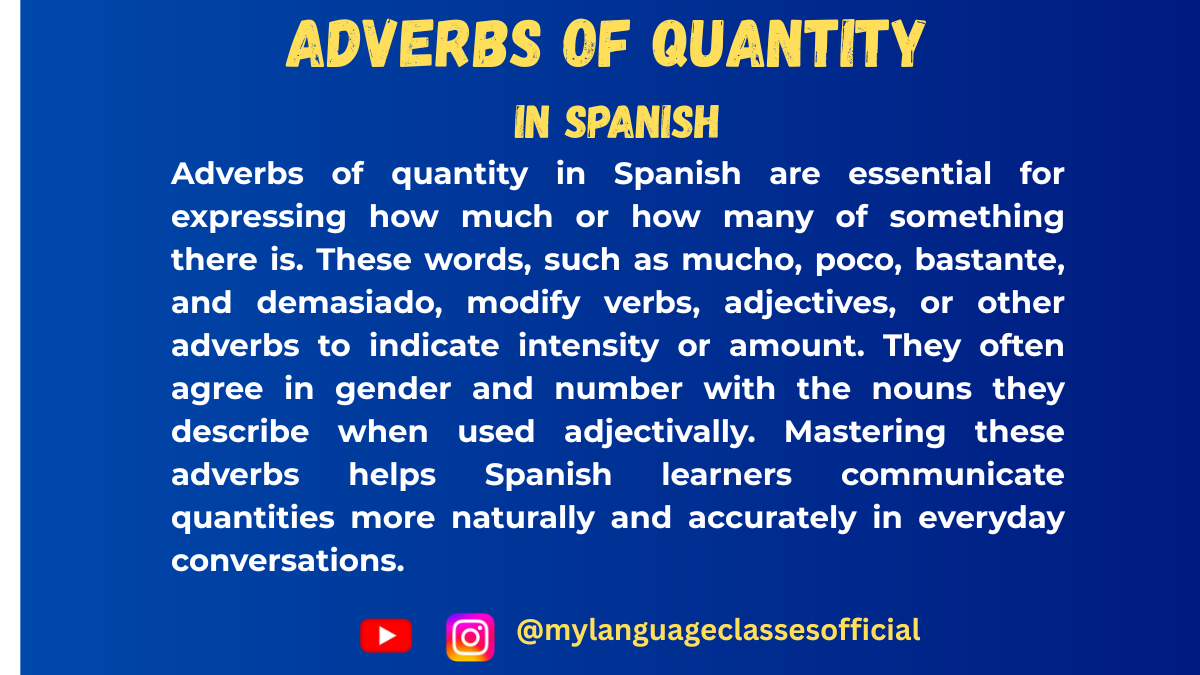Your cart is currently empty!
Tag: My Spanish class
-

Everything You Need to Know About POR in Spanish
One of the most challenging aspects of learning Spanish is understanding the difference between por and para. Both words can be translated as “for,” but they are used in different contexts. In this blog post, we will focus entirely on por, explaining its various uses, common expressions, grammatical considerations, and examples to help you master it like a native speaker.
Main Uses of POR in Spanish
The preposition por is used in multiple contexts in Spanish. Below is a breakdown of its main uses along with example sentences.
Usage Explanation Example Sentence Cause or Reason Used to explain the reason behind an action (similar to “because of”). Me castigaron por llegar tarde. (They punished me for arriving late.) Duration of Time Used to express how long something lasts. Estudié español por tres años. (I studied Spanish for three years.) Exchange or Substitution Used when something is exchanged or substituted. Te doy mi libro por tu cuaderno. (I’ll give you my book for your notebook.) Means of Communication or Transportation Used to indicate how something is done. Hablamos por teléfono. (We spoke on the phone.) / Viajé por tren. (I traveled by train.) Movement Through a Place Used when referring to motion through or around a place. Caminamos por el parque. (We walked through the park.) General Location Used to indicate an approximate location. Vive por aquí. (He/She lives around here.) Agent in Passive Voice Used to indicate who performed an action in the passive voice. El libro fue escrito por Gabriel García Márquez. (The book was written by Gabriel García Márquez.) Multiplication or Measurement Used in mathematics or measurements. Cinco por cinco es veinticinco. (Five times five is twenty-five.) Motive or Reason for an Action (on behalf of someone) Used when doing something for someone else. Lo hice por ti. (I did it for you.) Gratitude or Apology Used to express thanks or apologies. Gracias por tu ayuda. (Thanks for your help.) Emotion Towards Someone or Something Used to express feelings. Tengo mucho respeto por mis profesores. (I have a lot of respect for my teachers.)
Common Expressions with POR
Many fixed expressions in Spanish include por. Here is a list of some of the most common ones, their meanings, and example sentences.
Expression Meaning Example Sentence Por favor Please Por favor, dime la verdad. (Please, tell me the truth.) Por supuesto Of course Por supuesto que te ayudaré. (Of course, I will help you.) Por fin Finally Por fin llegaron las vacaciones. (Finally, the holidays arrived.) Por lo menos At least Necesito dormir por lo menos ocho horas. (I need to sleep at least eight hours.) Por ejemplo For example Me gustan los deportes, por ejemplo, el fútbol. (I like sports, for example, soccer.) Por ahora For now No tengo trabajo, por ahora. (I don’t have a job, for now.) Por si acaso Just in case Lleva un paraguas, por si acaso llueve. (Take an umbrella, just in case it rains.) Por desgracia Unfortunately Por desgracia, no puedo ir a la fiesta. (Unfortunately, I can’t go to the party.) Por todos lados Everywhere Hay turistas por todos lados. (There are tourists everywhere.) Por eso That’s why Está lloviendo, por eso llevamos paraguas. (It’s raining, that’s why we’re carrying umbrellas.) Por mi parte As for me Por mi parte, prefiero quedarme en casa. (As for me, I prefer to stay home.)
Things to Keep in Mind When Using POR
1. Gender and Number Agreement
- Por itself does not change for gender or number, but the articles and adjectives surrounding it must agree with the noun.
- Example: Caminamos por el bosque. (We walked through the forest.)
- Example: Pasamos por la plaza. (We passed through the square.)
2. When Not to Use POR
- Many learners confuse por and para. If you are referring to a destination, purpose, or deadline, use para instead of por.
- Correct: Este regalo es para ti. (This gift is for you.)
- Incorrect: Este regalo es por ti.
3. Using POR in Questions
- Por qué = Why? (Used in questions.)
- Example: ¿Por qué estudias español? (Why do you study Spanish?)
- Porque = Because (Used in answers.)
- Example: Estudio español porque me gusta. (I study Spanish because I like it.)
Conclusion
Mastering por is essential for fluency in Spanish. It appears in many everyday expressions, grammatical structures, and idiomatic phrases. By understanding its various meanings and practicing its usage, you will be able to speak Spanish more naturally. Keep an eye on key differences between por and para, and remember the most common expressions with por to improve your conversational skills!
If you enjoyed this lesson, be sure to check out more posts like this on my blog at My Language Classes. Don’t forget to subscribe my YouTube channel and follow me on Instagram for the latest language learning tips and lessons. Leave a comment below to share your thoughts, or ask any questions you have.
Happy learning! 😊
- Por itself does not change for gender or number, but the articles and adjectives surrounding it must agree with the noun.
-
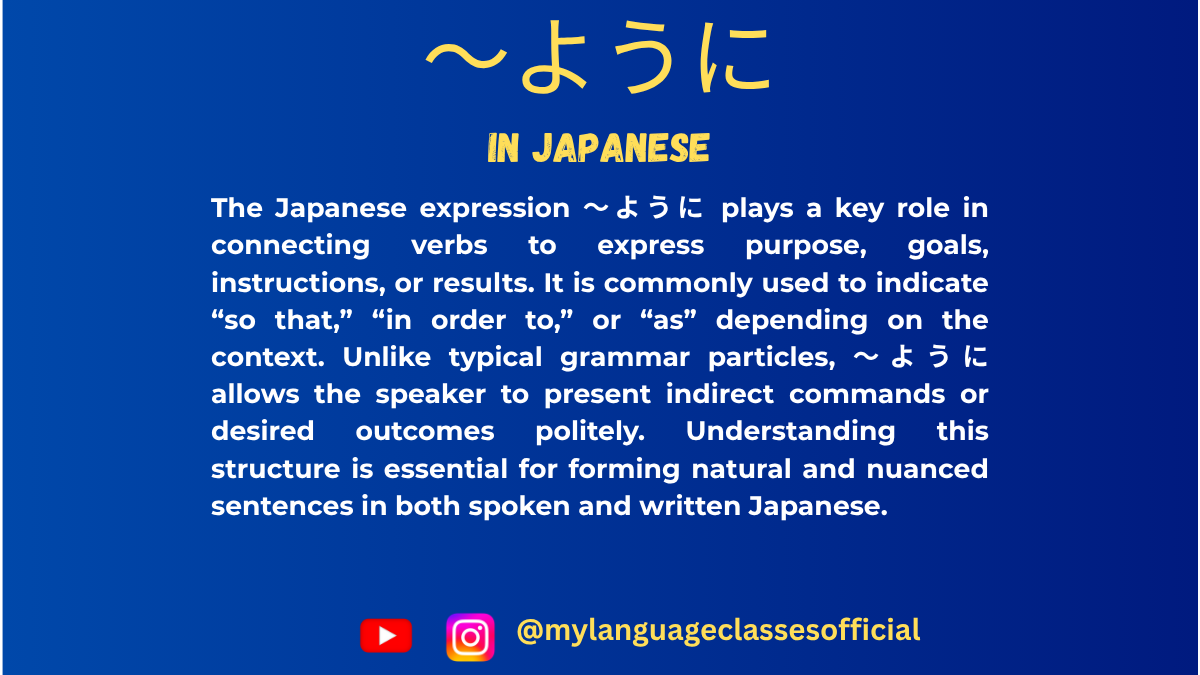
Understanding 〜ように in Japanese | My Language Classes
Using 〜ように in Japanese
The Japanese expression 「〜ように」 is an essential grammatical structure that serves various purposes, including expressing hopes, requests, instructions, comparisons, goals, and habitual actions. This guide will provide an in-depth look at the different uses of 「〜ように」, along with clear explanations and example sentences.
1. Expressing Hopes or Wishes
「〜ように」 is used to express a hope or wish for something to happen, similar to saying “I hope that…” in English.
Structure:
Verb (potential form / negative form) + ように
Examples:
- 試験に合格できますように。
(Shiken ni goukaku dekimasu you ni.)
→ “I hope I can pass the exam.” - 雨が降らないように。
(Ame ga furanai you ni.)
→ “I hope it doesn’t rain.”
2. Expressing Goals or Objectives
This usage is similar to saying “in order to” in English. It indicates a goal or purpose for an action.
Structure:
Verb (potential form / dictionary form) + ように
Examples:
- 日本語が話せるように、毎日勉強しています。
(Nihongo ga hanaseru you ni, mainichi benkyou shiteimasu.)
→ “I study every day in order to be able to speak Japanese.” - 風邪を引かないように、マフラーをします。
(Kaze wo hikanai you ni, mafuraa wo shimasu.)
→ “I wear a scarf so that I don’t catch a cold.”
3. Giving Instructions or Advice (Indirect Commands)
When making polite or indirect requests, suggestions, or advice, 「〜ように」 is often used.
Structure:
Verb (plain non-past form) + ように 言う / 注意する / 頼む / 伝える
Examples:
- 先生は学生に宿題を忘れないように言いました。
(Sensei wa gakusei ni shukudai wo wasurenai you ni iimashita.)
→ “The teacher told the students not to forget their homework.” - 医者に早く寝るように注意された。
(Isha ni hayaku neru you ni chuui sareta.)
→ “The doctor advised me to sleep early.” - 彼に遅刻しないように頼みました。
(Kare ni chikoku shinai you ni tanomimashita.)
→ “I asked him not to be late.”
4. Making Comparisons
When used with verbs like なる (to become), 「〜ように」 can indicate a comparison or similarity.
Structure:
Noun + のように / Verb (plain form) + ように
Examples:
- 彼は先生のように話します。
(Kare wa sensei no you ni hanashimasu.)
→ “He speaks like a teacher.” - この部屋はまるでホテルのように綺麗です。
(Kono heya wa marude hoteru no you ni kirei desu.)
→ “This room is as clean as a hotel.”
5. Indicating Habitual Actions or Natural Consequences
This structure shows that something naturally happens or occurs habitually.
Structure:
Verb (dictionary form / negative form) + ようになる
Examples:
- 毎日練習して、日本語が話せるようになった。
(Mainichi renshuu shite, nihongo ga hanaseru you ni natta.)
→ “After practicing every day, I became able to speak Japanese.” - 最近、早く起きるようになりました。
(Saikin, hayaku okiru you ni narimashita.)
→ “Recently, I have started waking up early.”
6. Expressing Something Indirectly
When introducing a previous statement or explanation, 「〜ように」 can mean “as mentioned before” or “as expected.”
Structure:
Verb (plain form) + ように
Examples:
- 前に話したように、このプロジェクトは重要です。
(Mae ni hanashita you ni, kono purojekuto wa juuyou desu.)
→ “As I mentioned before, this project is important.” - 先生が言ったように、復習することが大切です。
(Sensei ga itta you ni, fukushuu suru koto ga taisetsu desu.)
→ “As the teacher said, reviewing is important.”
7. Expressing a Desired Outcome in a Prayer or Wish
This structure is common in prayers and formal expressions.
Structure:
Verb (potential form / negative form) + ように
Examples:
- みんなが幸せになりますように。
(Minna ga shiawase ni narimasu you ni.)
→ “I hope everyone becomes happy.” - 悪いことが起こらないように。
(Warui koto ga okoranai you ni.)
→ “I hope nothing bad happens.”
Summary: Situations Where 「〜ように」 is Used
Usage Meaning Example Expressing Hopes or Wishes “I hope that…” 試験に合格できますように。 Expressing Goals “In order to…” 日本語が話せるように勉強しています。 Giving Instructions / Advice Indirect commands 先生は学生に宿題を忘れないように言いました。 Making Comparisons “Like…” 彼は先生のように話します。 Indicating Habitual Actions “To become able to…” 日本語が話せるようになった。 Introducing Statements “As mentioned…” 前に話したように、このプロジェクトは重要です。 Expressing Wishes in Prayer Formal wishes みんなが幸せになりますように。
Conclusion
「〜ように」 is a versatile and essential grammar structure in Japanese. Understanding its different uses can greatly enhance your ability to communicate hopes, goals, indirect commands, comparisons, and habitual changes. By mastering this structure, you will sound more natural and fluent in Japanese!
Would you like me to cover any other grammar points in detail? Let me know in the comments!
If you enjoyed this lesson, be sure to check out more posts like this on my blog at My Language Classes. Don’t forget to subscribe my YouTube channel and follow me on Instagram for the latest language learning tips and lessons. Leave a comment below to share your thoughts, or ask any questions you have about nouns.
Happy learning! 😊
- 試験に合格できますように。
-
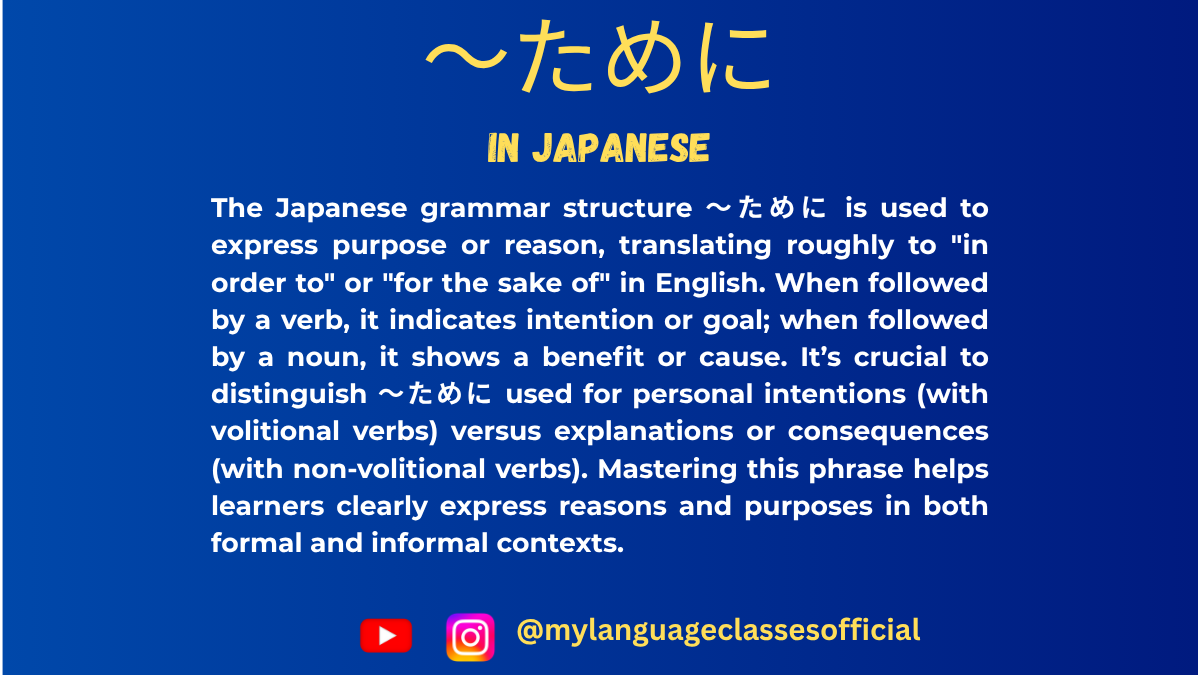
Using 〜ために in Japanese | My Language Classes
Understanding 〜ために in Japanese
In Japanese, “〜ために” (tame ni) is a highly versatile grammatical structure used to indicate purpose, reason, or benefit. Understanding its different meanings and contexts is crucial for mastering the Japanese language.
This article will explain all the possible uses of “ために” along with example sentences and a list of situations where it is commonly used.
**1. Expressing Purpose (目的)
The most common use of “ために” is to express purpose or intention. In this case, it is used with dictionary form verbs or nouns.**
Structure:
- Verb (dictionary form) + ために
- Noun + の + ために
Examples:
- 体重を減らすために歩いています。 (I walk in order to lose weight.)
- 簡単な日本語を勉強するためにこのアプリを使う。 (I use this app to study simple Japanese.)
- 健康のために毎日ヨガをしています。 (For my health, I do yoga every day.)
Note:
- “ために” is used for intentional actions performed by someone with a goal in mind.
2. Expressing Reason or Cause (原因)
“ために” can also be used to express a reason or cause for a particular event, similar to “because of” in English.
Structure:
- Verb (plain past form) + ために
- Noun + の + ために
Examples:
- 天気が悪かったためにゲームが中止された。 (Because of bad weather, the game was canceled.)
- 病気のために休んだ。 (I took a break because of illness.)
- 仕事が大変だったためにとても疲れています。 (Because work was difficult, I am very tired.)
Note:
- In this case, the outcome is not controlled by the speaker and is often negative.
3. Expressing Benefit or Effect (利益)
Another meaning of “ために” is to indicate the benefit or positive effect of something.
Structure:
- Noun + の + ために
Examples:
- 子供のために私たちは最良の教育を提供したい。 (For the benefit of children, we want to provide the best education.)
- 世界のために安全な環境を作りましょう。 (For the benefit of the world, let’s create a safe environment.)
Note:
- This use of “ために” is often found in formal speech, policies, and slogans.
4. “ために” vs. “ように” (Comparison)
Both “ために” and “ように” express purpose, but they have different uses:
Phrase Used with Meaning ために Dictionary-form verbs (intentional) Purpose (the subject can control the action) ように Potential-form verbs or non-intentional actions Purpose (the subject cannot directly control the action) Examples:
- ために: 体重を減らすために歩いています。 (I walk in order to lose weight.)
- ように: 日本語を話せるように勉強している。 (I study so that I can speak Japanese.)
Key difference: “ために” is used when the subject can control the outcome, while “ように” is used for situations where the outcome depends on ability or an external factor.
Situations Where 〜ために is Used
Situation Example Expressing Purpose 旅行するためにお金を貯めています。 Expressing Reason 天気が悪かったためにコンサートが中止された。 Expressing Benefit 社会のために活動しています。
Conclusion
The structure “ために” is an essential part of Japanese grammar, used to express purpose, reason, and benefit. Mastering its different uses will greatly improve your ability to form complex and meaningful sentences in Japanese.
Understanding the differences between “ために” and similar expressions like “ように” will help you sound more natural in Japanese conversations. Keep practicing and using “ために” in different contexts!
If you enjoyed this lesson, be sure to check out more posts like this on my blog at My Language Classes. Don’t forget to subscribe my YouTube channel and follow me on Instagram for the latest language learning tips and lessons. Leave a comment below to share your thoughts, or ask any questions you have about nouns.
Happy learning! 😊
-
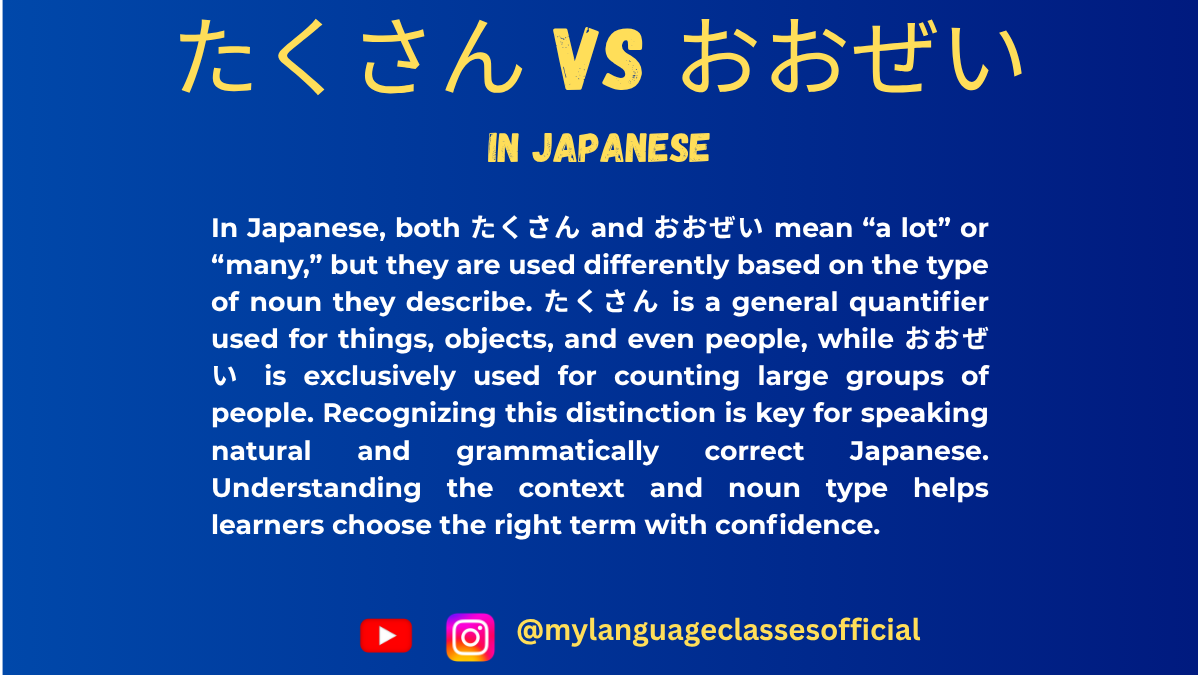
たくさん vs おおぜい: the Differences in Japanese | My Language Classes
たくさん vs おおぜい
When learning Japanese, many students come across the words たくさん (takusan) and おおぜい (oozei), both of which mean “a lot” or “many.” However, they are not interchangeable in every situation. Understanding their nuances will help you use them naturally in conversations and writing.
1. Basic Meaning and Key Difference
- たくさん (takusan): Means “a lot,” “many,” or “plenty” and can be used for both countable and uncountable nouns.
- おおぜい (oozei): Specifically refers to “a large number of people” and is used only for people.
2. Usage of たくさん (takusan)
A. With Countable and Uncountable Nouns
- たくさん can be used with both things that can be counted (books, apples, pens) and things that cannot be counted (water, happiness, love).
Examples:
- 机の上に本がたくさんあります。
Tsukue no ue ni hon ga takusan arimasu.
→ There are many books on the desk. - 今日は仕事がたくさんあります。
Kyou wa shigoto ga takusan arimasu.
→ I have a lot of work today. - 私はお金をたくさん持っています。
Watashi wa okane o takusan motteimasu.
→ I have a lot of money.
B. Placement of たくさん in a Sentence
- Before the noun (less common in daily speech):
- たくさんの友達がいます。(Takusan no tomodachi ga imasu.)
→ I have many friends.
- たくさんの友達がいます。(Takusan no tomodachi ga imasu.)
- After the noun (more natural):
- 友達がたくさんいます。(Tomodachi ga takusan imasu.)
→ I have many friends.
- 友達がたくさんいます。(Tomodachi ga takusan imasu.)
- With verbs (indicating an action done in large amounts):
- ご飯をたくさん食べました。(Gohan o takusan tabemashita.)
→ I ate a lot of food.
- ご飯をたくさん食べました。(Gohan o takusan tabemashita.)
3. Usage of おおぜい (oozei)
A. Used Only for a Large Number of People
- おおぜい is exclusively used when talking about a crowd, a large number of people, or a gathering.
Examples:
- コンサートにはおおぜいの人が来ました。
Konsaato ni wa oozei no hito ga kimashita.
→ A large number of people came to the concert. - その町には観光客がおおぜいいました。
Sono machi ni wa kankoukyaku ga oozei imashita.
→ There were many tourists in that town. - おおぜいの学生が試験を受けました。
Oozei no gakusei ga shiken o ukemashita.
→ A lot of students took the exam.
B. Placement of おおぜい in a Sentence
- Before the noun:
- おおぜいの人が集まりました。(Oozei no hito ga atsumarimashita.)
→ Many people gathered.
- おおぜいの人が集まりました。(Oozei no hito ga atsumarimashita.)
- After the noun (less common but acceptable):
- 人がおおぜい集まりました。(Hito ga oozei atsumarimashita.)
→ A lot of people gathered.
- 人がおおぜい集まりました。(Hito ga oozei atsumarimashita.)
4. Situations Where たくさん and おおぜい Are Used
Situation Use たくさん Use おおぜい Talking about a large number of objects (books, apples, cars, etc.) ✅ Yes ❌ No Talking about a large quantity of uncountable things (water, love, money, etc.) ✅ Yes ❌ No Talking about a large number of people ✅ Yes ✅ Yes Talking about a crowd or a gathering of people ❌ No ✅ Yes Used with verbs like “eat” or “buy” (大量に食べる, 大量に買う) ✅ Yes ❌ No Used before a noun as an adjective ✅ Yes (たくさんの) ✅ Yes (おおぜいの) Used after a noun naturally ✅ Yes ✅ Yes (but limited to people) 5. Summary of Key Differences
Word Meaning Used for Example Sentence たくさん (takusan) A lot, many, plenty Both people and things 友達がたくさんいます。 (I have many friends.) おおぜい (oozei) A large number of people, crowd Only people コンサートにおおぜいの人が来ました。 (A large number of people came to the concert.) 6. Common Mistakes to Avoid
- ❌ おおぜいの本があります。 (Oozei no hon ga arimasu.) → Incorrect, because おおぜい is only for people.
- ✅ たくさんの本があります。 (Takusan no hon ga arimasu.) → Correct, because たくさん can be used for books.
- ❌ たくさんの人がいた。 (Takusan no hito ga ita.) → Grammatically correct, but おおぜいの人がいた sounds more natural when referring to a crowd.
7. Conclusion
Both たくさん and おおぜい mean “many,” but their usage differs depending on what you are referring to. たくさん is more versatile as it can be used with both things and people, while おおぜい is exclusively used for a large number of people. By keeping these differences in mind, you can use these words accurately and naturally in your Japanese conversations!
By mastering these distinctions, you can enhance your fluency and express yourself more precisely in Japanese. Keep practicing, and soon using たくさん and おおぜい correctly will become second nature! Happy learning! 😊
If you enjoyed this lesson, be sure to check out more posts like this on my blog at My Language Classes. Don’t forget to subscribe my YouTube channel and follow me on Instagram for the latest language learning tips and lessons. Leave a comment below to share your thoughts, or ask any questions you have about nouns.
Happy learning! 😊
-
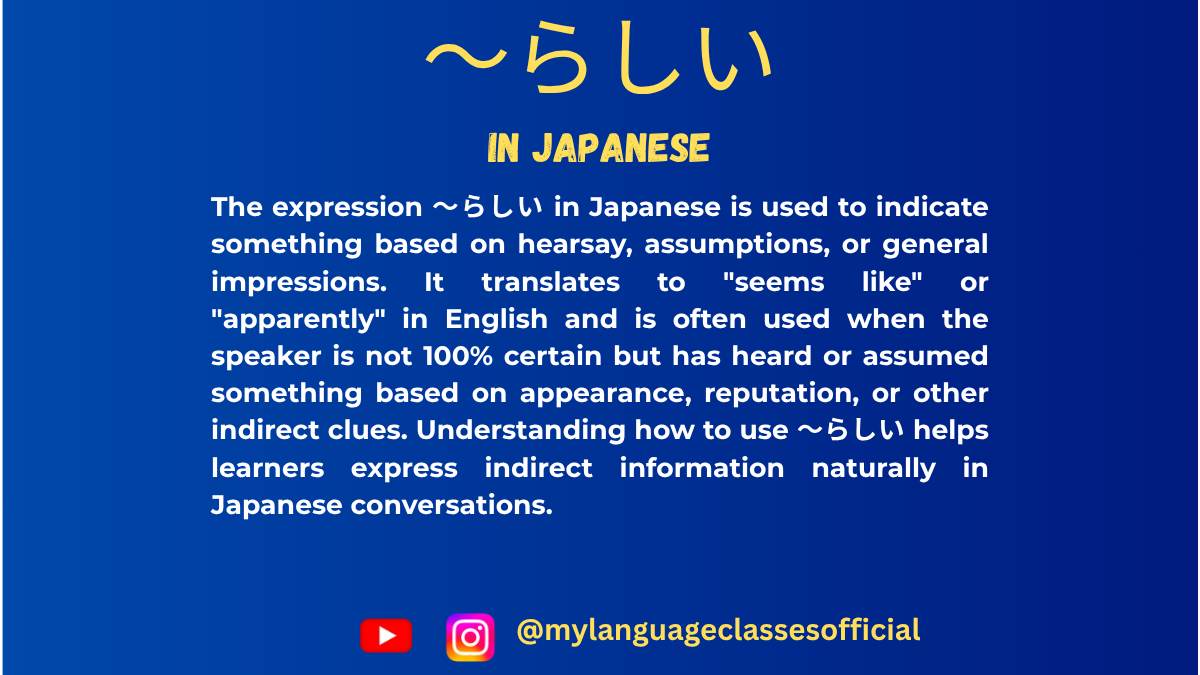
Understanding 〜らしい in Japanese | My Language Classes
Understanding 〜らしい in Japanese
When learning Japanese, one of the essential expressions to understand is 〜らしい. This suffix plays a vital role in expressing assumptions, hearsay, characteristics, and appropriateness. In this blog post, we will explore all possible usages of 〜らしい, providing clear explanations and examples.
1. Expressing Hearsay or Second-hand Information
One of the most common uses of 〜らしい is to indicate information that the speaker has heard from someone else but has not personally verified.
Structure:
Verb (Plain Form) + らしい
い-adjective (Plain Form) + らしい
な-adjective + らしい
Noun + らしいExamples:
- そのレストランは美味しいらしいよ。
(I heard that restaurant is delicious.) - たろうは今日休むらしい。
(I heard that Tarou is taking the day off today.) - この映画はめちゃくちゃ面白いらしい。
(I heard that this movie is really interesting.)
Usage Note:
Compared to そうだ, which is also used for hearsay, らしい implies that the information is based on indirect sources rather than direct observation.
2. Expressing Assumptions or Inferences
Another way to use 〜らしい is when making an assumption based on evidence.
Examples:
- たくさんの人が黒い服を着ている。 お蔵式があったらしい。
(Many people are wearing black clothes. It looks like there was a funeral.) - あの子はプロ野球選手の子どもらしい。
(That child seems to be the son of a professional baseball player.)
Usage Note:
This is different from ようだ, which is used for assumptions based on visual evidence, whereas らしい is based on reasoning or known facts.
3. Expressing Typical Characteristics
〜らしい can also be used to describe something that has the typical characteristics of a person, thing, or behavior.
Examples:
- このラーメンは日本らしい味だね。
(This ramen has a very “Japanese” flavor.) - かれは仕事に小さいことまで注意を払う。真面目らしい人だ。
(He pays attention to small details in his work. He is a serious person.) - 她はいつも元気で、すごく子どもらしい。
(She is always energetic, very much like a child.)
Usage Note:
This usage expresses the “essence” of something or someone. It is similar to みたい but is more about inherent qualities rather than just resemblance.
4. Expressing Suitability or Appropriateness
In some cases, 〜らしい can be used to indicate something that fits a certain expectation or role.
Examples:
- 日本らしいけしきゃんの誕生日プレゼントを買いたい。
(I want to buy a birthday present that is “Japanese-like”.) - 少年らしい仕事を求めている。
(Looking for work suitable for young people.)
Usage Note:
This is closely related to the “typical characteristics” meaning but emphasizes suitability rather than mere resemblance.
Situations Where 〜らしい is Used
Below is a list of common situations where 〜らしい is applicable:
- Hearsay – When conveying information heard from others.
- Inference – When making an assumption based on indirect evidence.
- Typical Characteristics – When describing something as having the essence of a person, thing, or behavior.
- Suitability – When expressing something as being appropriate for a certain role or image.
- Rumors – When talking about unverified rumors or gossip.
Final Thoughts
Mastering 〜らしい is essential for expressing assumptions, typicality, and hearsay in Japanese. While it might seem tricky at first, practicing with real-life examples and distinguishing it from similar expressions like そうだ and ようだ will help you use it naturally.
By understanding these nuances, you’ll be able to sound more fluent and natural in your Japanese conversations. Keep practicing, and don’t hesitate to use 〜らしい in different situations!
If you enjoyed this lesson, be sure to check out more posts like this on my blog at My Language Classes. Don’t forget to subscribe my YouTube channel and follow me on Instagram for the latest language learning tips and lessons. Leave a comment below to share your thoughts, or ask any questions you have about nouns.
Happy learning! 😊
- そのレストランは美味しいらしいよ。
-

Adverbs of Place in Spanish: A Complete Guide
Adverbs of place (adverbios de lugar) are essential in Spanish to indicate where an action takes place. They help provide spatial context and are frequently used in daily conversations. In this blog, we will explore the most common adverbs of place, their meanings, and how to use them correctly in sentences.
Understanding Adverbs of Place
Adverbs of place describe the location of an action or object. They answer the questions: Where? (¿Dónde?) and To where? (¿Adónde?)
These adverbs do not change in gender or number, as adjectives do, but their placement and meaning depend on the sentence context.
Common Adverbs of Place and Their Meanings
Spanish Adverb Meaning Aquí Here Allí There (not too far) Allá Over there (far away) Cerca Near Lejos Far Encima On top Debajo Below, under Enfrente In front Detrás Behind Dentro Inside Fuera Outside Al lado Next to, beside Entre Between Alrededor Around
Common Expressions with Adverbs of Place
Here are some daily expressions using adverbs of place with their meanings and example sentences:
1. Aquí (Here)
- Estoy aquí. (I am here.)
- Pon el libro aquí. (Put the book here.)
- Aquí se come bien. (Here, one eats well.)
2. Allí / Allá (There / Over there)
- El coche está allí. (The car is there.)
- Allí vive mi abuela. (My grandmother lives there.)
- Vamos allá para ver la fiesta. (Let’s go over there to see the party.)
3. Cerca / Lejos (Near / Far)
- El supermercado está cerca. (The supermarket is near.)
- El aeropuerto está lejos de aquí. (The airport is far from here.)
- Mi casa está cerca del parque. (My house is near the park.)
4. Encima / Debajo (On top / Under)
- El libro está encima de la mesa. (The book is on top of the table.)
- El perro está debajo de la silla. (The dog is under the chair.)
- Las llaves están encima del escritorio. (The keys are on top of the desk.)
5. Enfrente / Detrás (In front / Behind)
- El cine está enfrente del restaurante. (The cinema is in front of the restaurant.)
- Juan está detrás de la puerta. (Juan is behind the door.)
6. Dentro / Fuera (Inside / Outside)
- Los niños están dentro de la casa. (The children are inside the house.)
- Voy a esperar fuera. (I will wait outside.)
How to Use Adverbs of Place Correctly?
1. Articles and Agreement
- Unlike adjectives, adverbs of place do not agree in gender or number.
- However, they often require a definite article (el, la, los, las) when specifying the location:
- Encima de la mesa (On top of the table)
- Debajo del coche (Under the car)
2. Adverbs with Prepositions
- Some adverbs need prepositions like de to clarify their meaning:
- Encima de, debajo de, detrás de, delante de
- El gato está debajo de la cama. (The cat is under the bed.)
3. Position in a Sentence
- Adverbs of place typically come after the verb or at the end of the sentence:
- El niño juega afuera. (The boy plays outside.)
- Nos vemos allí. (See you there.)
- In questions, adverbs of place often come at the beginning:
- ¿Dónde está tu mochila? (Where is your backpack?)
Adverbs of Place in Different Contexts
1. Motion vs. Static Position
- When describing movement towards a place, use hacia or para:
- Voy hacia allá. (I am going over there.)
- Camina para dentro. (Walk inside.)
- When indicating a fixed position, use adverbs alone:
- Estoy aquí. (I am here.)
2. Expressing Approximate Location
- Por aquí / Por allí (Around here / around there):
- Debe estar por aquí. (It must be around here.)
Conclusion
Adverbs of place are fundamental for effective communication in Spanish. By mastering their meanings, correct usage, and placement in sentences, you can confidently express spatial relationships in everyday conversations. Practice using them with different verbs and prepositions to sound more fluent and natural in Spanish!
Do you have any questions or need more examples? Let me know in the comments below!
If you enjoyed this lesson, be sure to check out more posts like this on my blog at My Language Classes. Don’t forget to subscribe my YouTube channel and follow me on Instagram for the latest language learning tips and lessons. Leave a comment below to share your thoughts, or ask any questions you have.
Happy learning! 😊
-
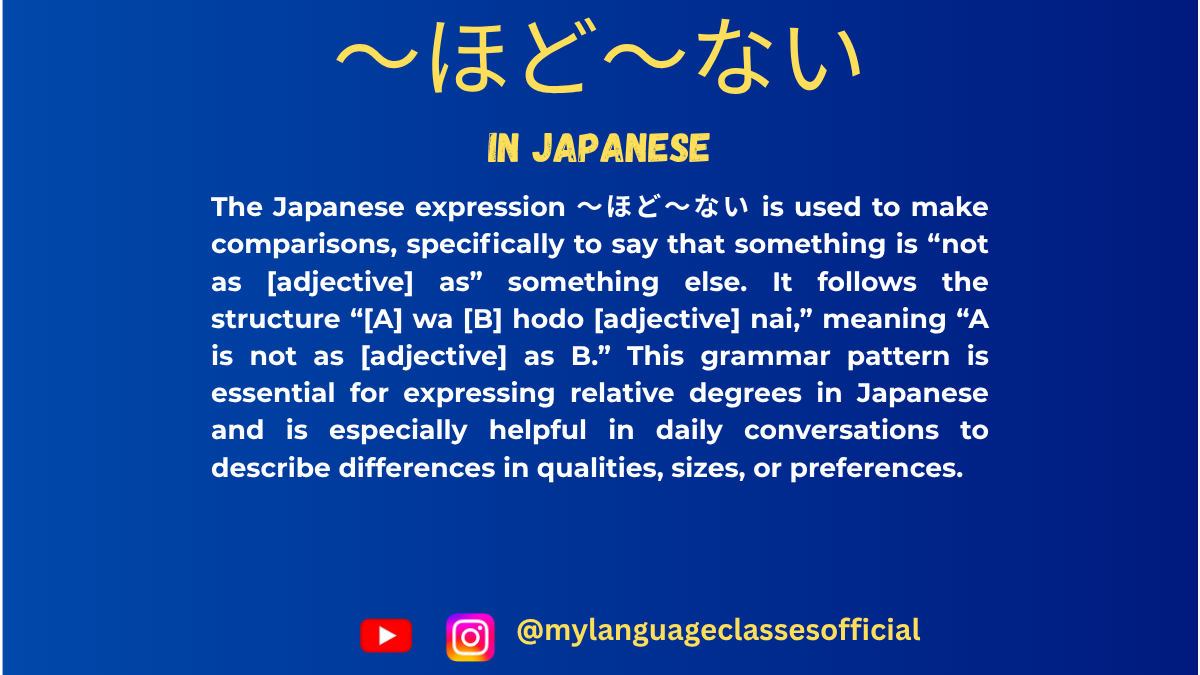
Using 〜ほど〜ない in Japanese | My Language Classes
Understanding 〜ほど〜ない in Japanese
The Japanese grammar pattern 「〜ほど〜ない」 is commonly used for making comparisons and expressing degree or extent. It implies that something is “not as much as” something else. This phrase is often translated as “not as… as…” in English.
Basic Structure of 〜ほど〜ない
The structure of this grammar pattern is as follows:
Noun + ほど + Adjective (ない-form)
or
Verb (dictionary form) + ほど + Adjective (ない-form)
General Meaning
「A ほど B ない」 means that B is not as A.
- A is the standard of comparison.
- B is the thing being compared.
Examples:
- この町は東京ほど賑やかではない。
(Kono machi wa Tōkyō hodo nigiyaka de wa nai.)
→ This town is not as lively as Tokyo. - 彼は私ほど速く走れない。
(Kare wa watashi hodo hayaku hashirenai.)
→ He cannot run as fast as I do. - この問題は思ったほど難しくない。
(Kono mondai wa omotta hodo muzukashiku nai.)
→ This problem is not as difficult as I thought.
Situations Where 〜ほど〜ない is Used
1. Comparing Extent or Degree
- Used when two things are compared, but the second one (B) has less intensity than the first (A).
Example:
北海道の冬は東京の冬ほど寒くない。
(Hokkaidō no fuyu wa Tōkyō no fuyu hodo samuku nai.)
→ Hokkaido’s winter is not as cold as Tokyo’s winter.2. Expressing Subjective Opinions
- Often used to express personal opinions about differences in perception.
Example:
数学は国語ほど難しくないと思います。
(Sūgaku wa kokugo hodo muzukashiku nai to omoimasu.)
→ I think math is not as difficult as Japanese.3. Negative Comparison in Abilities or Characteristics
- Used when comparing someone’s ability or characteristics with another’s.
Example:
彼の英語は先生ほど上手ではない。
(Kare no eigo wa sensei hodo jōzu de wa nai.)
→ His English is not as good as the teacher’s.4. Comparing Expectations vs Reality
- Used when expectations were high, but the actual situation is not as expected.
Example:
この映画は評判ほど面白くない。
(Kono eiga wa hyōban hodo omoshiroku nai.)
→ This movie is not as interesting as its reputation suggests.5. Comparing Feelings and Emotions
- Used when talking about feelings that are not as strong as expected.
Example:
彼は私が思ったほど優しくない。
(Kare wa watashi ga omotta hodo yasashiku nai.)
→ He is not as kind as I thought.6. Comparing Physical Condition or Health
- Used to compare health conditions or physical states.
Example:
風邪は思ったほどひどくない。
(Kaze wa omotta hodo hidoku nai.)
→ The cold is not as bad as I thought.7. Comparing Amount or Frequency
- Used when comparing quantity or frequency of actions.
Example:
今日は昨日ほど忙しくない。
(Kyō wa kinō hodo isogashiku nai.)
→ Today is not as busy as yesterday.8. Comparing Importance or Necessity
- Used when comparing levels of importance or necessity.
Example:
宿題はテストほど大事ではない。
(Shukudai wa tesuto hodo daiji de wa nai.)
→ Homework is not as important as tests.9. Comparing Strength of Desire or Preference
- Used to compare desires, preferences, or interests.
Example:
私は映画を見るのが好きですが、本を読むほど好きではない。
(Watashi wa eiga o miru no ga suki desu ga, hon o yomu hodo suki de wa nai.)
→ I like watching movies, but not as much as reading books.
Key Points to Remember About 〜ほど〜ない
- It is used for making comparisons where the second element has less intensity.
- It is often used to express subjective opinions.
- It is used to compare expectations vs reality.
- It can be used in various contexts: ability, frequency, amount, physical conditions, and emotions.
- It follows a simple pattern: “A ほど B ない”, where A is the standard, and B is the thing being compared.
Conclusion
The 「〜ほど〜ない」 grammar pattern is an essential part of Japanese when making negative comparisons. Mastering it will help you express your opinions, compare things effectively, and sound more natural in conversations. Make sure to practice using this structure in daily life to reinforce your understanding!
If you enjoyed this lesson, be sure to check out more posts like this on my blog at My Language Classes. Don’t forget to subscribe my YouTube channel and follow me on Instagram for the latest language learning tips and lessons. Leave a comment below to share your thoughts, or ask any questions you have about nouns.
Happy learning! 😊
-
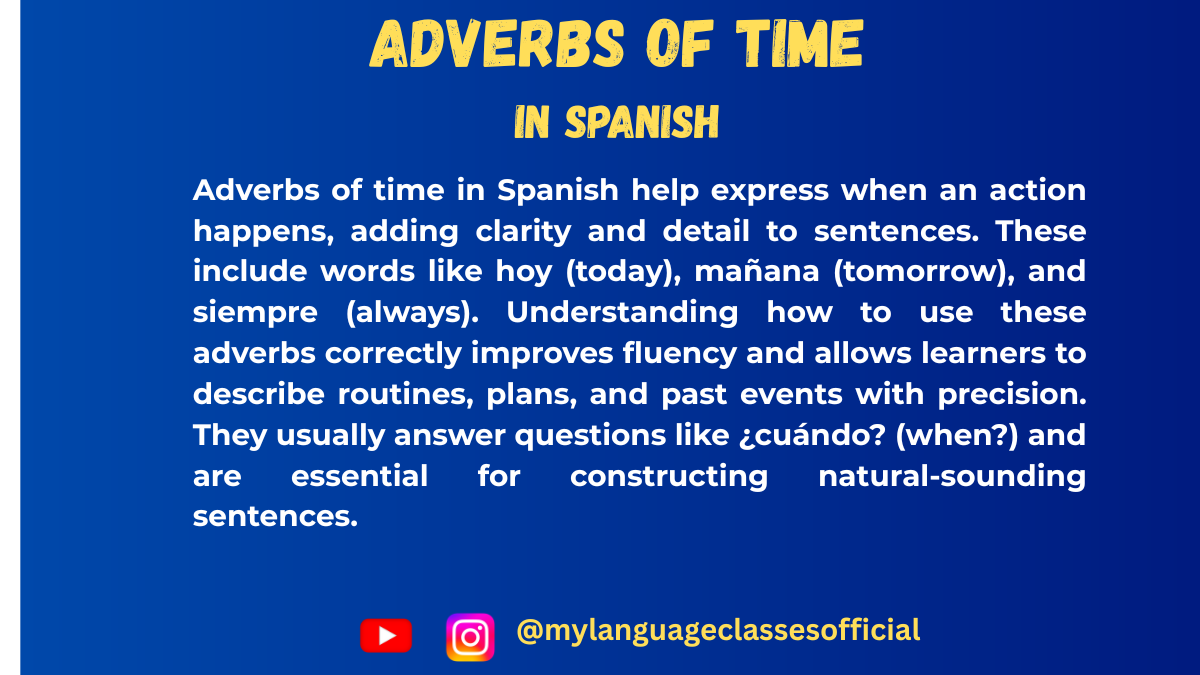
Adverbs of Time in Spanish: A Complete Guide
Adverbs of time (“los adverbios de tiempo”) are essential in Spanish to indicate when an action takes place. They help provide clarity and context to sentences, making conversations more precise. In this article, we will explore common Spanish adverbs of time, their meanings, examples, and grammatical considerations.
What Are Adverbs of Time?
Adverbs of time modify verbs, adjectives, or other adverbs by indicating the timing of an action. They answer questions like ¿Cuándo? (When?) and ¿Cada cuánto tiempo? (How often?).
Common Spanish Adverbs of Time
Here is a list of frequently used adverbs of time in Spanish along with their meanings and example sentences:
1. Adverbs for Specific Points in Time
- Hoy (Today)
- Hoy es un día especial. (Today is a special day.)
- Mañana (Tomorrow)
- Mañana voy al médico. (Tomorrow I am going to the doctor.)
- Ayer (Yesterday)
- Ayer llovió mucho. (Yesterday it rained a lot.)
- Ahora (Now)
- Ahora estoy ocupado. (Now I am busy.)
- Luego (Later)
- Voy al cine, luego te llamo. (I am going to the cinema, later I will call you.)
- Antes (Before)
- Antes de salir, apaga la luz. (Before leaving, turn off the light.)
- Después (After)
- Después de cenar, salimos a caminar. (After dinner, we go for a walk.)
2. Adverbs for Frequency
- Siempre (Always)
- Siempre me levanto temprano. (I always wake up early.)
- Nunca / Jamás (Never)
- Nunca fumo. (I never smoke.)
- Jamás lo volveré a hacer. (I will never do it again.)
- A menudo (Often)
- Voy al gimnasio a menudo. (I go to the gym often.)
- De vez en cuando (From time to time)
- De vez en cuando voy al teatro. (From time to time, I go to the theater.)
- Raramente (Rarely)
- Raramente veo televisión. (I rarely watch TV.)
- Casi nunca (Almost never)
- Casi nunca como comida rápida. (I almost never eat fast food.)
3. Adverbs for Duration
- Todavía / Aún (Still, yet)
- Todavía no he terminado. (I have not finished yet.)
- Ya (Already)
- Ya terminé la tarea. (I already finished the homework.)
- Por fin / Finalmente (Finally)
- Finalmente llegó el paquete. (The package finally arrived.)
- Desde entonces (Since then)
- Desde entonces no hemos hablado. (Since then, we have not spoken.)
- Mientras (While)
- Escucho música mientras estudio. (I listen to music while I study.)
Grammar and Usage Considerations
1. Placement in a Sentence
- In most cases, adverbs of time appear at the beginning or the end of a sentence:
- Hoy tengo clases. (Today I have classes.)
- Tengo clases hoy. (I have classes today.)
- Some adverbs, like ya, are placed before the verb:
- Ya terminé mi trabajo. (I already finished my work.)
2. Agreement and Gender Considerations
- Unlike adjectives, adverbs do not change in gender or number.
- However, some time expressions require articles or prepositions, such as:
- El lunes pasado (Last Monday) vs. Los lunes (On Mondays)
- En la mañana (In the morning) vs. Por la mañana (During the morning)
Forming Adverbs of Time from Adjectives
1. Regular Formation (Adding -mente)
Many adverbs are formed by adding -mente to the feminine singular form of adjectives:
- Rápido (Fast) → Rápidamente (Quickly)
- Frecuente (Frequent) → Frecuentemente (Frequently)
2. Irregular Formation
Some adverbs do not follow the regular -mente rule and must be memorized:
- Bien (Well), Mal (Badly), Tarde (Late), Temprano (Early)
- Example: Él llegó tarde a la reunión. (He arrived late to the meeting.)
3. Using Prepositional Phrases as Adverbs of Time
Some expressions function as adverbs when combined with prepositions:
- De vez en cuando (From time to time)
- Cada día (Every day)
- Hace un rato (A while ago)
Common Mistakes to Avoid
- Confusing “ya” and “todavía”:
- Ya means “already”: Ya hice mi tarea. (I already did my homework.)
- Todavía means “still”: Todavía estoy haciendo mi tarea. (I am still doing my homework.)
- Misplacing “nunca” in negative sentences:
- Correct: Nunca he estado en España. (I have never been to Spain.)
- Incorrect: No he estado nunca en España. (Although this is sometimes used in spoken Spanish, it’s not grammatically preferred.)
Conclusion
Adverbs of time are fundamental for constructing clear and accurate sentences in Spanish. Understanding their placement, variations, and common expressions will enhance your fluency. By practicing these adverbs in different contexts, you will develop a more natural and precise way of speaking Spanish.
If you enjoyed this lesson, be sure to check out more posts like this on my blog at My Language Classes. Don’t forget to subscribe my YouTube channel and follow me on Instagram for the latest language learning tips and lessons. Leave a comment below to share your thoughts, or ask any questions you have.
Happy learning! 😊
- Hoy (Today)
-
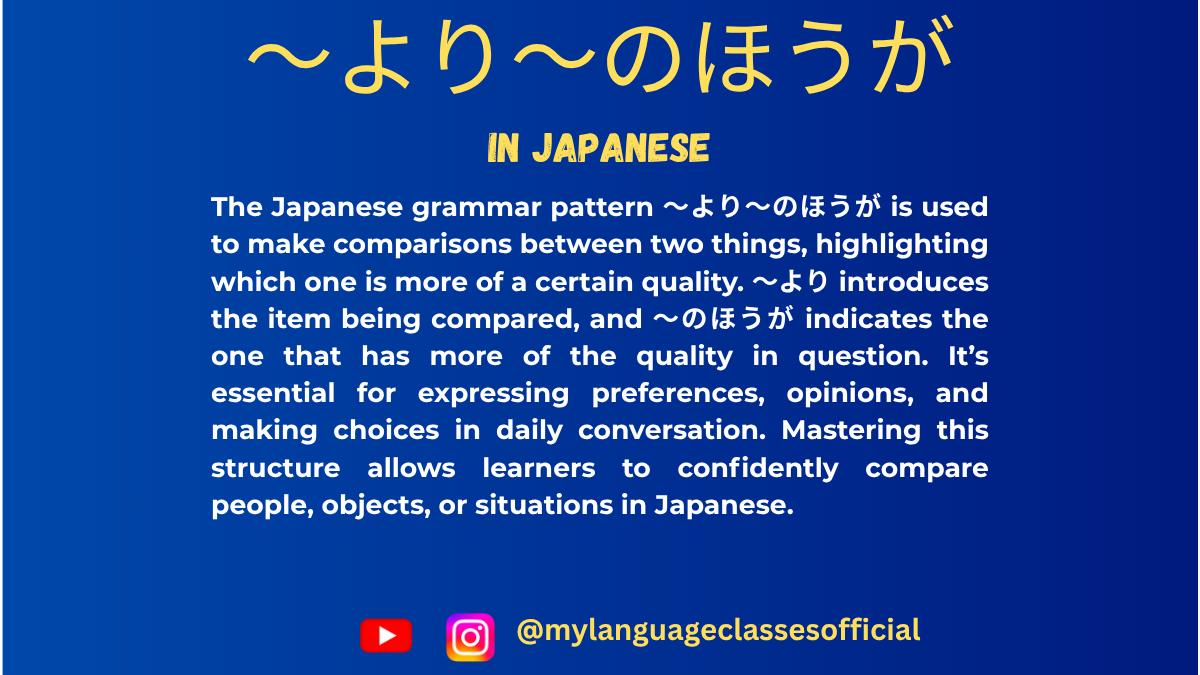
Understanding 〜より〜のほうが in Japanese | My Language Classes
Understanding 〜より〜のほうが
The construction 〜より〜のほうが is an essential tool in Japanese for making comparisons. It translates to “X is more than Y” or “X is better/more suitable than Y” and is widely used in everyday conversations, formal contexts, and written communication. This blog post dives into its meaning, usage, and various scenarios.
Structure of 〜より〜のほうが
The pattern is straightforward:
- Yより Xのほうが adjective/descriptive phrase.
- Yより: Indicates the thing being compared (Y).
- Xのほうが: Highlights the preferred or superior item (X).
Example:
- 犬より猫のほうが好きです。
(I like cats more than dogs.)
Core Uses of 〜より〜のほうが
- Preference
When expressing a preference between two items, activities, or options:- 旅行より勉強のほうが楽しいです。
(Studying is more fun than traveling.)
- 旅行より勉強のほうが楽しいです。
- Quantitative Comparisons
Highlighting differences in measurable qualities like size, speed, or price:- バスより電車のほうが早いです。
(Trains are faster than buses.) - このレストランよりあのレストランのほうが安いです。
(That restaurant is cheaper than this one.)
- バスより電車のほうが早いです。
- Capabilities
Used to compare abilities or skills:- 英語より日本語のほうが得意です。
(I’m better at Japanese than English.)
- 英語より日本語のほうが得意です。
- Frequency or Intensity
Comparing how often or how strongly something occurs:- 冬より夏のほうが好きです。
(I like summer more than winter.)
- 冬より夏のほうが好きです。
- Hypotheticals
For discussing hypothetical preferences or outcomes:- 映画館より家で映画を見たほうがいいです。
(Watching a movie at home is better than going to the cinema.)
- 映画館より家で映画を見たほうがいいです。
- Suitability
Indicating one option is more suitable for a specific purpose:- この仕事には男性より女性のほうが適しています。
(For this job, women are more suitable than men.)
- この仕事には男性より女性のほうが適しています。
Situations Where 〜より〜のほうが is Used
- Daily Conversations
- Comparing food, hobbies, weather, or locations:
- 寿司よりラーメンのほうがおいしいと思います。
(I think ramen is tastier than sushi.)
- 寿司よりラーメンのほうがおいしいと思います。
- Comparing food, hobbies, weather, or locations:
- Business and Professional Settings
- Discussing product qualities or work efficiency:
- この方法よりその方法のほうが効率的です。
(That method is more efficient than this one.)
- この方法よりその方法のほうが効率的です。
- Discussing product qualities or work efficiency:
- Travel and Leisure
- Comparing destinations, travel modes, or activities:
- 海外旅行より国内旅行のほうが安心です。
(Domestic travel is safer than international travel.)
- 海外旅行より国内旅行のほうが安心です。
- Comparing destinations, travel modes, or activities:
- Education and Learning
- Comparing subjects or teaching methods:
- 自習より先生に教えてもらうほうがいいです。
(Being taught by a teacher is better than self-study.)
- 自習より先生に教えてもらうほうがいいです。
- Comparing subjects or teaching methods:
- Relationships and Social Scenarios
- Evaluating people or interpersonal qualities:
- 彼より彼女のほうが優しいです。
(She is kinder than him.)
- 彼より彼女のほうが優しいです。
- Evaluating people or interpersonal qualities:
Key Notes
- Implied Context:
In conversational Japanese, the context often allows for the omission of repetitive elements:- 映画よりドラマのほうが好きです。(I like dramas more than movies.)
Can be shortened to:- ドラマのほうが好きです。 (I like dramas more.)
- 映画よりドラマのほうが好きです。(I like dramas more than movies.)
- Neutrality:
The phrase is neutral and doesn’t carry judgmental connotations, making it versatile for all scenarios. - Politeness Levels:
Depending on the situation, you can adjust politeness levels:- Casual: 〜より〜のほうがいい。
- Polite: 〜より〜のほうがいいです。
- Formal: 〜より〜のほうが適切です。
Practice Examples
- 自転車より車のほうが速いです。
(Cars are faster than bicycles.) - テレビを見るより本を読むほうがいいです。
(Reading books is better than watching TV.) - 東京より大阪のほうが住みやすいと思います。
(I think Osaka is easier to live in than Tokyo.)
By mastering 〜より〜のほうが, you can convey nuanced preferences and comparisons effectively. Practice using it in different contexts to build fluency!
What comparisons will you try making today? Let me know in the comments!
If you enjoyed this lesson, be sure to check out more posts like this on my blog at My Language Classes. Don’t forget to subscribe my YouTube channel and follow me on Instagram for the latest language learning tips and lessons. Leave a comment below to share your thoughts, or ask any questions you have about nouns.
Happy learning! 😊
- Yより Xのほうが adjective/descriptive phrase.

